Strategic IT Management: Business Plan and Model Analysis Report
VerifiedAdded on 2022/11/09
|26
|7344
|413
Report
AI Summary
This report delves into the realm of strategic IT management, examining the core components of business plans and business models. It commences with an exploration of the essential elements of a business plan, encompassing business identification, competitive analysis, and funding requirements. The report then elucidates the functions of a business plan, its practical applications, and the roles of various stakeholders such as potential investors, consumers, and lenders. A significant portion of the report is dedicated to analyzing Amazon as a case study, evaluating its business strategies, particularly its effective business plan in a competitive market, and operational model. The report further breaks down various types of business models, including manufacturing, distributor, retailer, franchise, e-commerce, and freemium models. The role of information technology in e-commerce is also highlighted. The report concludes with insights into business plan expectations, including growth projections and market dynamics.
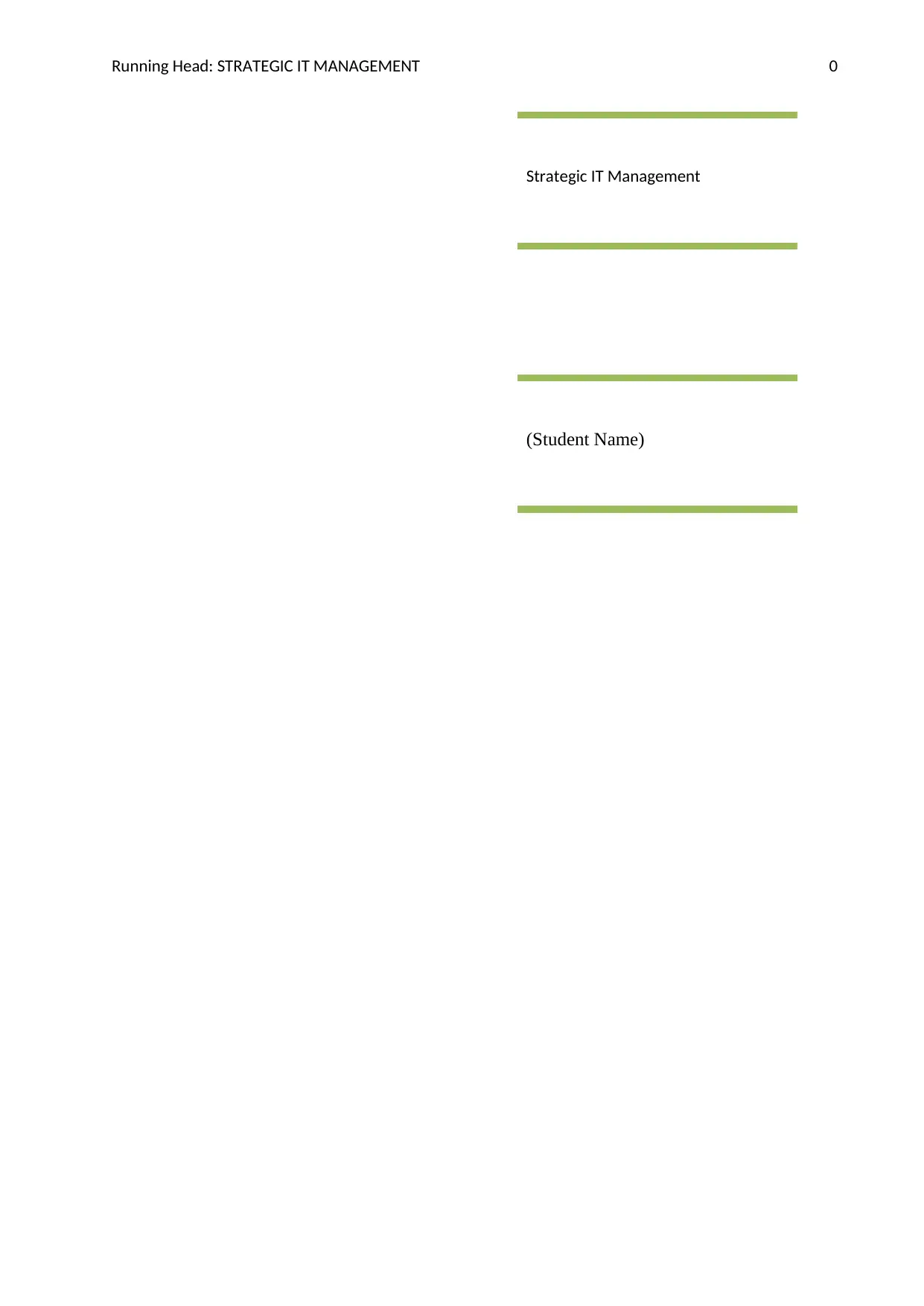
Running Head: STRATEGIC IT MANAGEMENT 0
Strategic IT Management
(Student Name)
Strategic IT Management
(Student Name)
Paraphrase This Document
Need a fresh take? Get an instant paraphrase of this document with our AI Paraphraser

STRATEGIC IT MANAGEMENT 1
Table of Contents
Business Plan.............................................................................................................................2
Business Model..........................................................................................................................3
Value Proposition.......................................................................................................................7
Market Analysis.........................................................................................................................8
Compliance and Regulatory Issues......................................................................................11
Investing Money.......................................................................................................................13
Importance of cost benefits analysis:...................................................................................13
Sensitivity Analysis..............................................................................................................14
Financial model....................................................................................................................15
Conclusion................................................................................................................................16
References................................................................................................................................18
Table of Contents
Business Plan.............................................................................................................................2
Business Model..........................................................................................................................3
Value Proposition.......................................................................................................................7
Market Analysis.........................................................................................................................8
Compliance and Regulatory Issues......................................................................................11
Investing Money.......................................................................................................................13
Importance of cost benefits analysis:...................................................................................13
Sensitivity Analysis..............................................................................................................14
Financial model....................................................................................................................15
Conclusion................................................................................................................................16
References................................................................................................................................18
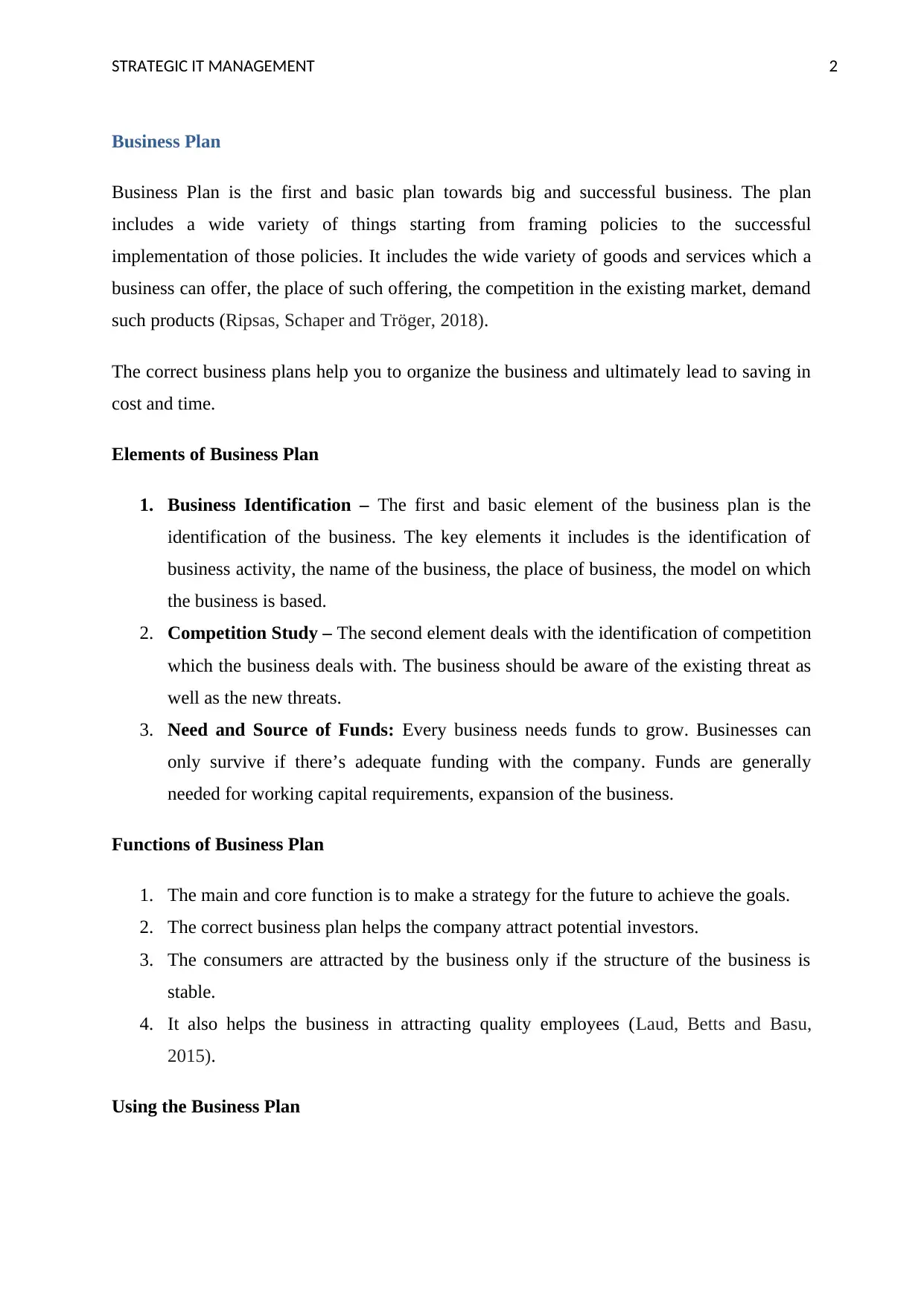
STRATEGIC IT MANAGEMENT 2
Business Plan
Business Plan is the first and basic plan towards big and successful business. The plan
includes a wide variety of things starting from framing policies to the successful
implementation of those policies. It includes the wide variety of goods and services which a
business can offer, the place of such offering, the competition in the existing market, demand
such products (Ripsas, Schaper and Tröger, 2018).
The correct business plans help you to organize the business and ultimately lead to saving in
cost and time.
Elements of Business Plan
1. Business Identification – The first and basic element of the business plan is the
identification of the business. The key elements it includes is the identification of
business activity, the name of the business, the place of business, the model on which
the business is based.
2. Competition Study – The second element deals with the identification of competition
which the business deals with. The business should be aware of the existing threat as
well as the new threats.
3. Need and Source of Funds: Every business needs funds to grow. Businesses can
only survive if there’s adequate funding with the company. Funds are generally
needed for working capital requirements, expansion of the business.
Functions of Business Plan
1. The main and core function is to make a strategy for the future to achieve the goals.
2. The correct business plan helps the company attract potential investors.
3. The consumers are attracted by the business only if the structure of the business is
stable.
4. It also helps the business in attracting quality employees (Laud, Betts and Basu,
2015).
Using the Business Plan
Business Plan
Business Plan is the first and basic plan towards big and successful business. The plan
includes a wide variety of things starting from framing policies to the successful
implementation of those policies. It includes the wide variety of goods and services which a
business can offer, the place of such offering, the competition in the existing market, demand
such products (Ripsas, Schaper and Tröger, 2018).
The correct business plans help you to organize the business and ultimately lead to saving in
cost and time.
Elements of Business Plan
1. Business Identification – The first and basic element of the business plan is the
identification of the business. The key elements it includes is the identification of
business activity, the name of the business, the place of business, the model on which
the business is based.
2. Competition Study – The second element deals with the identification of competition
which the business deals with. The business should be aware of the existing threat as
well as the new threats.
3. Need and Source of Funds: Every business needs funds to grow. Businesses can
only survive if there’s adequate funding with the company. Funds are generally
needed for working capital requirements, expansion of the business.
Functions of Business Plan
1. The main and core function is to make a strategy for the future to achieve the goals.
2. The correct business plan helps the company attract potential investors.
3. The consumers are attracted by the business only if the structure of the business is
stable.
4. It also helps the business in attracting quality employees (Laud, Betts and Basu,
2015).
Using the Business Plan
⊘ This is a preview!⊘
Do you want full access?
Subscribe today to unlock all pages.

Trusted by 1+ million students worldwide
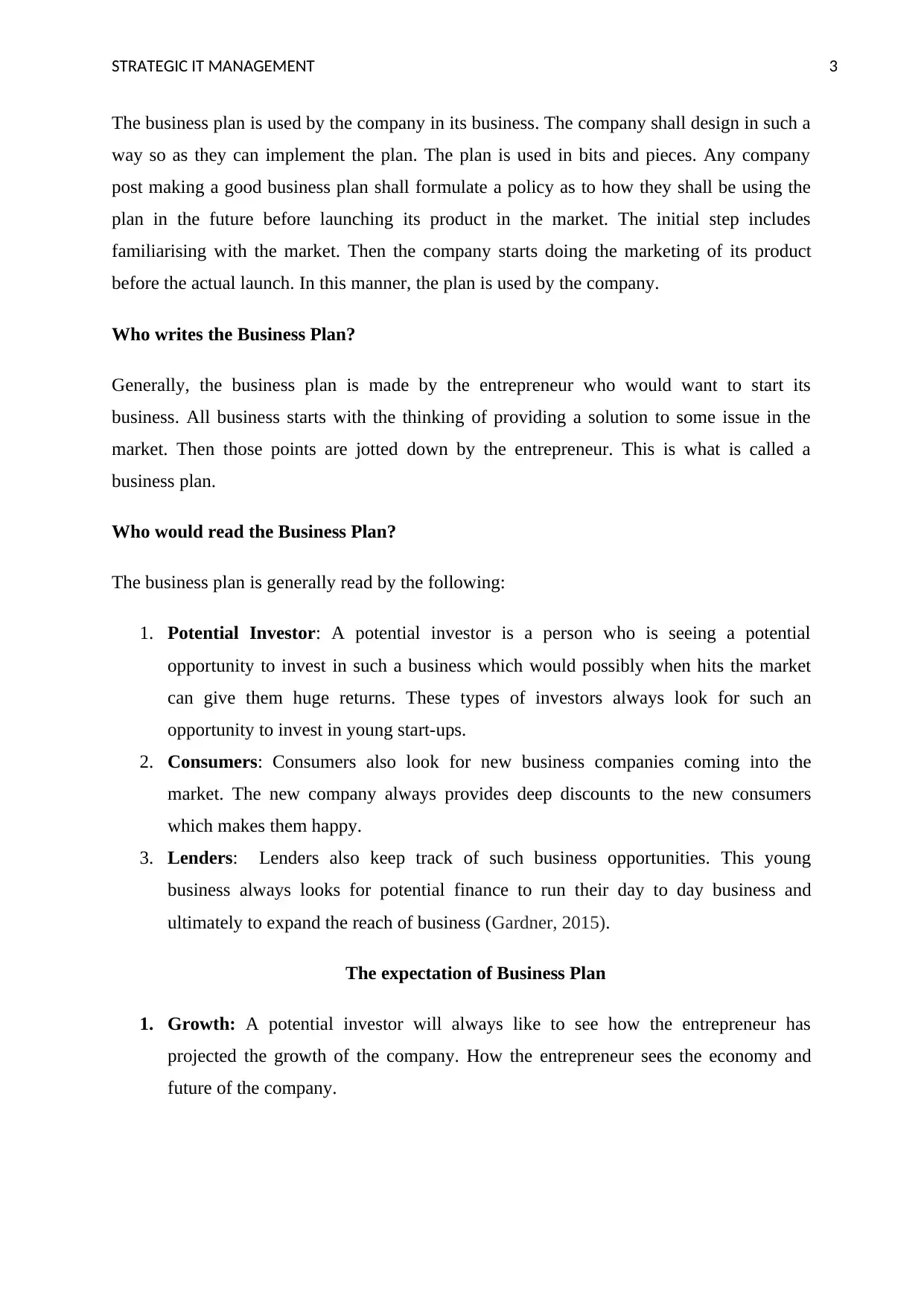
STRATEGIC IT MANAGEMENT 3
The business plan is used by the company in its business. The company shall design in such a
way so as they can implement the plan. The plan is used in bits and pieces. Any company
post making a good business plan shall formulate a policy as to how they shall be using the
plan in the future before launching its product in the market. The initial step includes
familiarising with the market. Then the company starts doing the marketing of its product
before the actual launch. In this manner, the plan is used by the company.
Who writes the Business Plan?
Generally, the business plan is made by the entrepreneur who would want to start its
business. All business starts with the thinking of providing a solution to some issue in the
market. Then those points are jotted down by the entrepreneur. This is what is called a
business plan.
Who would read the Business Plan?
The business plan is generally read by the following:
1. Potential Investor: A potential investor is a person who is seeing a potential
opportunity to invest in such a business which would possibly when hits the market
can give them huge returns. These types of investors always look for such an
opportunity to invest in young start-ups.
2. Consumers: Consumers also look for new business companies coming into the
market. The new company always provides deep discounts to the new consumers
which makes them happy.
3. Lenders: Lenders also keep track of such business opportunities. This young
business always looks for potential finance to run their day to day business and
ultimately to expand the reach of business (Gardner, 2015).
The expectation of Business Plan
1. Growth: A potential investor will always like to see how the entrepreneur has
projected the growth of the company. How the entrepreneur sees the economy and
future of the company.
The business plan is used by the company in its business. The company shall design in such a
way so as they can implement the plan. The plan is used in bits and pieces. Any company
post making a good business plan shall formulate a policy as to how they shall be using the
plan in the future before launching its product in the market. The initial step includes
familiarising with the market. Then the company starts doing the marketing of its product
before the actual launch. In this manner, the plan is used by the company.
Who writes the Business Plan?
Generally, the business plan is made by the entrepreneur who would want to start its
business. All business starts with the thinking of providing a solution to some issue in the
market. Then those points are jotted down by the entrepreneur. This is what is called a
business plan.
Who would read the Business Plan?
The business plan is generally read by the following:
1. Potential Investor: A potential investor is a person who is seeing a potential
opportunity to invest in such a business which would possibly when hits the market
can give them huge returns. These types of investors always look for such an
opportunity to invest in young start-ups.
2. Consumers: Consumers also look for new business companies coming into the
market. The new company always provides deep discounts to the new consumers
which makes them happy.
3. Lenders: Lenders also keep track of such business opportunities. This young
business always looks for potential finance to run their day to day business and
ultimately to expand the reach of business (Gardner, 2015).
The expectation of Business Plan
1. Growth: A potential investor will always like to see how the entrepreneur has
projected the growth of the company. How the entrepreneur sees the economy and
future of the company.
Paraphrase This Document
Need a fresh take? Get an instant paraphrase of this document with our AI Paraphraser
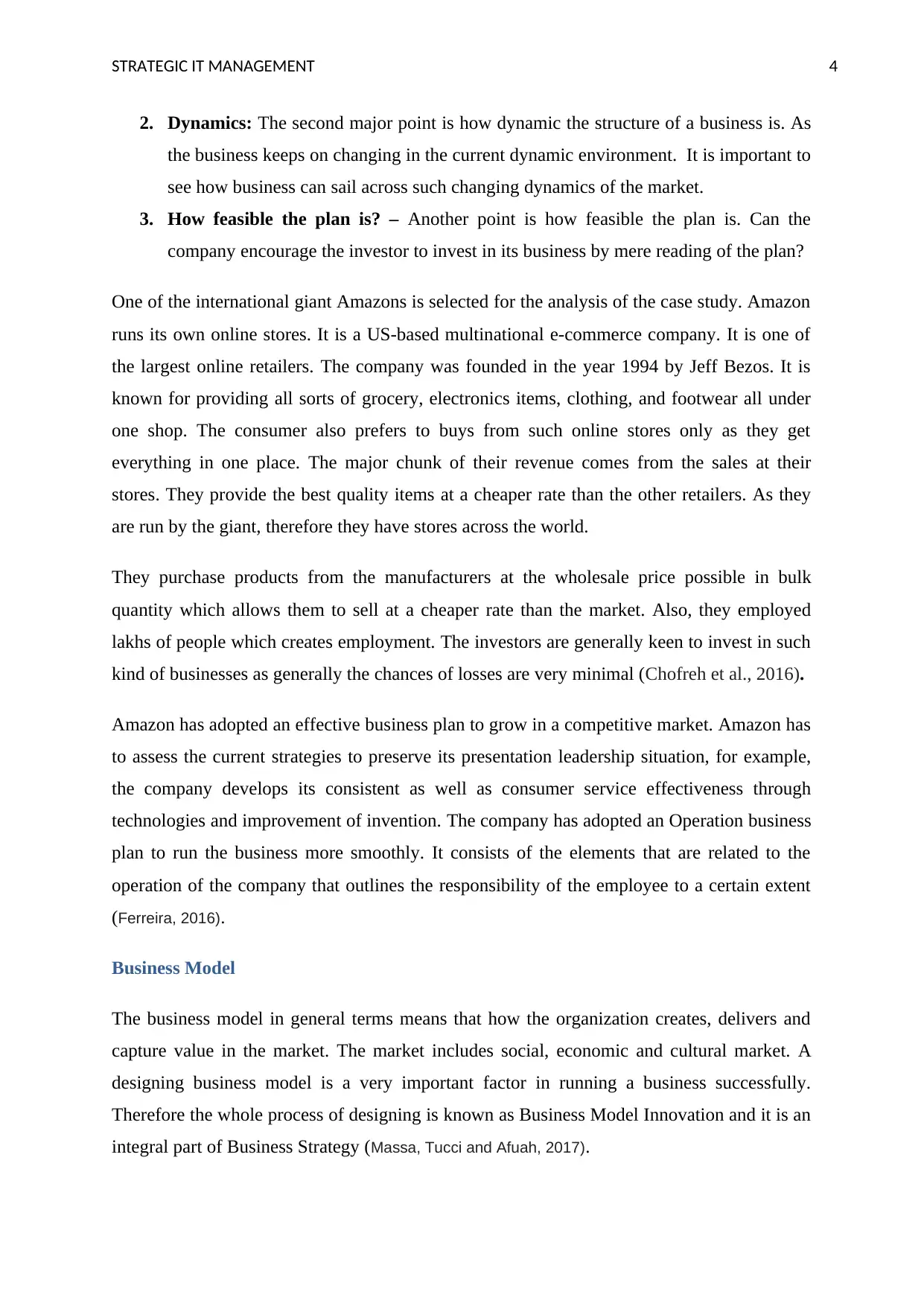
STRATEGIC IT MANAGEMENT 4
2. Dynamics: The second major point is how dynamic the structure of a business is. As
the business keeps on changing in the current dynamic environment. It is important to
see how business can sail across such changing dynamics of the market.
3. How feasible the plan is? – Another point is how feasible the plan is. Can the
company encourage the investor to invest in its business by mere reading of the plan?
One of the international giant Amazons is selected for the analysis of the case study. Amazon
runs its own online stores. It is a US-based multinational e-commerce company. It is one of
the largest online retailers. The company was founded in the year 1994 by Jeff Bezos. It is
known for providing all sorts of grocery, electronics items, clothing, and footwear all under
one shop. The consumer also prefers to buys from such online stores only as they get
everything in one place. The major chunk of their revenue comes from the sales at their
stores. They provide the best quality items at a cheaper rate than the other retailers. As they
are run by the giant, therefore they have stores across the world.
They purchase products from the manufacturers at the wholesale price possible in bulk
quantity which allows them to sell at a cheaper rate than the market. Also, they employed
lakhs of people which creates employment. The investors are generally keen to invest in such
kind of businesses as generally the chances of losses are very minimal (Chofreh et al., 2016).
Amazon has adopted an effective business plan to grow in a competitive market. Amazon has
to assess the current strategies to preserve its presentation leadership situation, for example,
the company develops its consistent as well as consumer service effectiveness through
technologies and improvement of invention. The company has adopted an Operation business
plan to run the business more smoothly. It consists of the elements that are related to the
operation of the company that outlines the responsibility of the employee to a certain extent
(Ferreira, 2016).
Business Model
The business model in general terms means that how the organization creates, delivers and
capture value in the market. The market includes social, economic and cultural market. A
designing business model is a very important factor in running a business successfully.
Therefore the whole process of designing is known as Business Model Innovation and it is an
integral part of Business Strategy (Massa, Tucci and Afuah, 2017).
2. Dynamics: The second major point is how dynamic the structure of a business is. As
the business keeps on changing in the current dynamic environment. It is important to
see how business can sail across such changing dynamics of the market.
3. How feasible the plan is? – Another point is how feasible the plan is. Can the
company encourage the investor to invest in its business by mere reading of the plan?
One of the international giant Amazons is selected for the analysis of the case study. Amazon
runs its own online stores. It is a US-based multinational e-commerce company. It is one of
the largest online retailers. The company was founded in the year 1994 by Jeff Bezos. It is
known for providing all sorts of grocery, electronics items, clothing, and footwear all under
one shop. The consumer also prefers to buys from such online stores only as they get
everything in one place. The major chunk of their revenue comes from the sales at their
stores. They provide the best quality items at a cheaper rate than the other retailers. As they
are run by the giant, therefore they have stores across the world.
They purchase products from the manufacturers at the wholesale price possible in bulk
quantity which allows them to sell at a cheaper rate than the market. Also, they employed
lakhs of people which creates employment. The investors are generally keen to invest in such
kind of businesses as generally the chances of losses are very minimal (Chofreh et al., 2016).
Amazon has adopted an effective business plan to grow in a competitive market. Amazon has
to assess the current strategies to preserve its presentation leadership situation, for example,
the company develops its consistent as well as consumer service effectiveness through
technologies and improvement of invention. The company has adopted an Operation business
plan to run the business more smoothly. It consists of the elements that are related to the
operation of the company that outlines the responsibility of the employee to a certain extent
(Ferreira, 2016).
Business Model
The business model in general terms means that how the organization creates, delivers and
capture value in the market. The market includes social, economic and cultural market. A
designing business model is a very important factor in running a business successfully.
Therefore the whole process of designing is known as Business Model Innovation and it is an
integral part of Business Strategy (Massa, Tucci and Afuah, 2017).
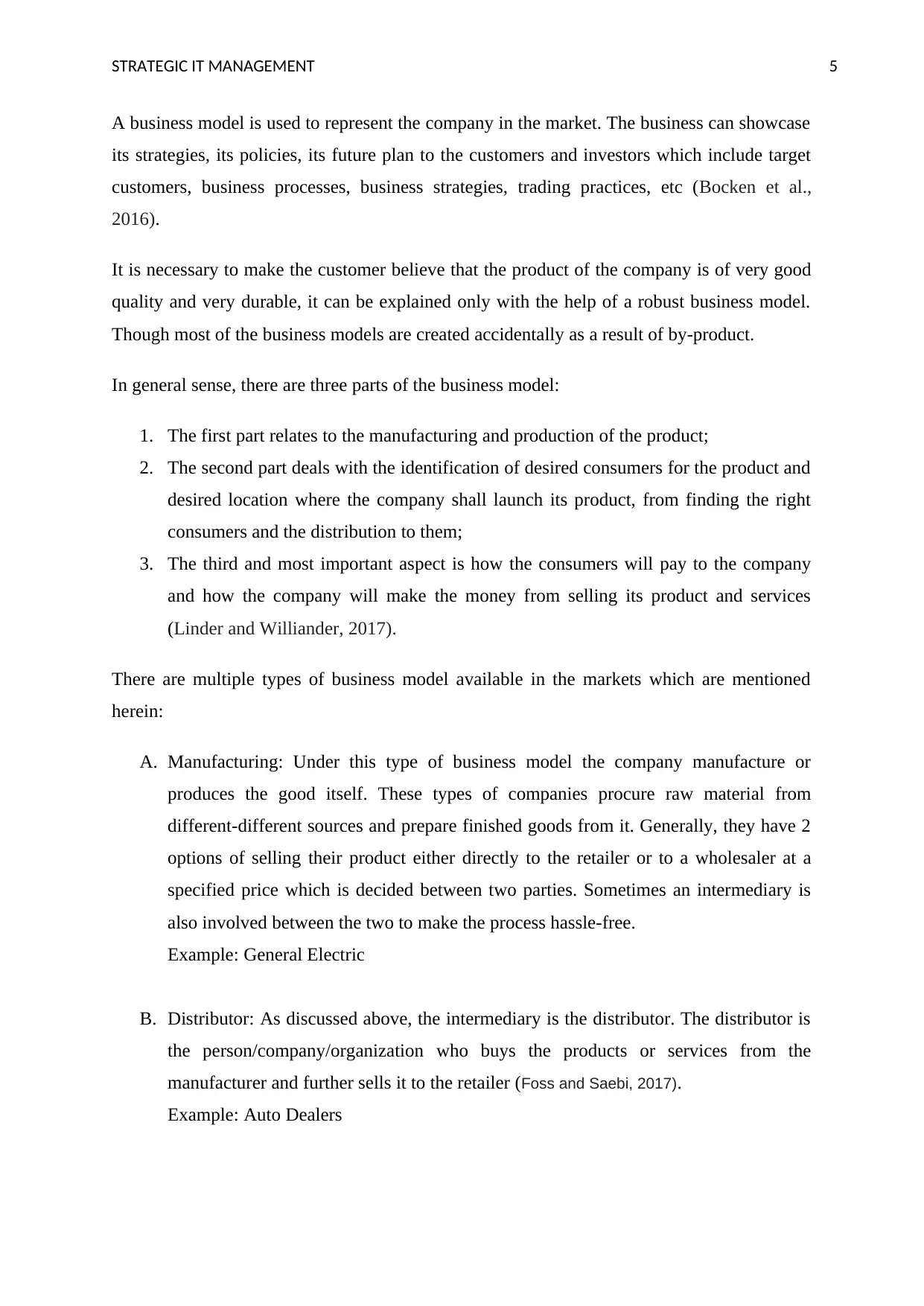
STRATEGIC IT MANAGEMENT 5
A business model is used to represent the company in the market. The business can showcase
its strategies, its policies, its future plan to the customers and investors which include target
customers, business processes, business strategies, trading practices, etc (Bocken et al.,
2016).
It is necessary to make the customer believe that the product of the company is of very good
quality and very durable, it can be explained only with the help of a robust business model.
Though most of the business models are created accidentally as a result of by-product.
In general sense, there are three parts of the business model:
1. The first part relates to the manufacturing and production of the product;
2. The second part deals with the identification of desired consumers for the product and
desired location where the company shall launch its product, from finding the right
consumers and the distribution to them;
3. The third and most important aspect is how the consumers will pay to the company
and how the company will make the money from selling its product and services
(Linder and Williander, 2017).
There are multiple types of business model available in the markets which are mentioned
herein:
A. Manufacturing: Under this type of business model the company manufacture or
produces the good itself. These types of companies procure raw material from
different-different sources and prepare finished goods from it. Generally, they have 2
options of selling their product either directly to the retailer or to a wholesaler at a
specified price which is decided between two parties. Sometimes an intermediary is
also involved between the two to make the process hassle-free.
Example: General Electric
B. Distributor: As discussed above, the intermediary is the distributor. The distributor is
the person/company/organization who buys the products or services from the
manufacturer and further sells it to the retailer (Foss and Saebi, 2017).
Example: Auto Dealers
A business model is used to represent the company in the market. The business can showcase
its strategies, its policies, its future plan to the customers and investors which include target
customers, business processes, business strategies, trading practices, etc (Bocken et al.,
2016).
It is necessary to make the customer believe that the product of the company is of very good
quality and very durable, it can be explained only with the help of a robust business model.
Though most of the business models are created accidentally as a result of by-product.
In general sense, there are three parts of the business model:
1. The first part relates to the manufacturing and production of the product;
2. The second part deals with the identification of desired consumers for the product and
desired location where the company shall launch its product, from finding the right
consumers and the distribution to them;
3. The third and most important aspect is how the consumers will pay to the company
and how the company will make the money from selling its product and services
(Linder and Williander, 2017).
There are multiple types of business model available in the markets which are mentioned
herein:
A. Manufacturing: Under this type of business model the company manufacture or
produces the good itself. These types of companies procure raw material from
different-different sources and prepare finished goods from it. Generally, they have 2
options of selling their product either directly to the retailer or to a wholesaler at a
specified price which is decided between two parties. Sometimes an intermediary is
also involved between the two to make the process hassle-free.
Example: General Electric
B. Distributor: As discussed above, the intermediary is the distributor. The distributor is
the person/company/organization who buys the products or services from the
manufacturer and further sells it to the retailer (Foss and Saebi, 2017).
Example: Auto Dealers
⊘ This is a preview!⊘
Do you want full access?
Subscribe today to unlock all pages.

Trusted by 1+ million students worldwide
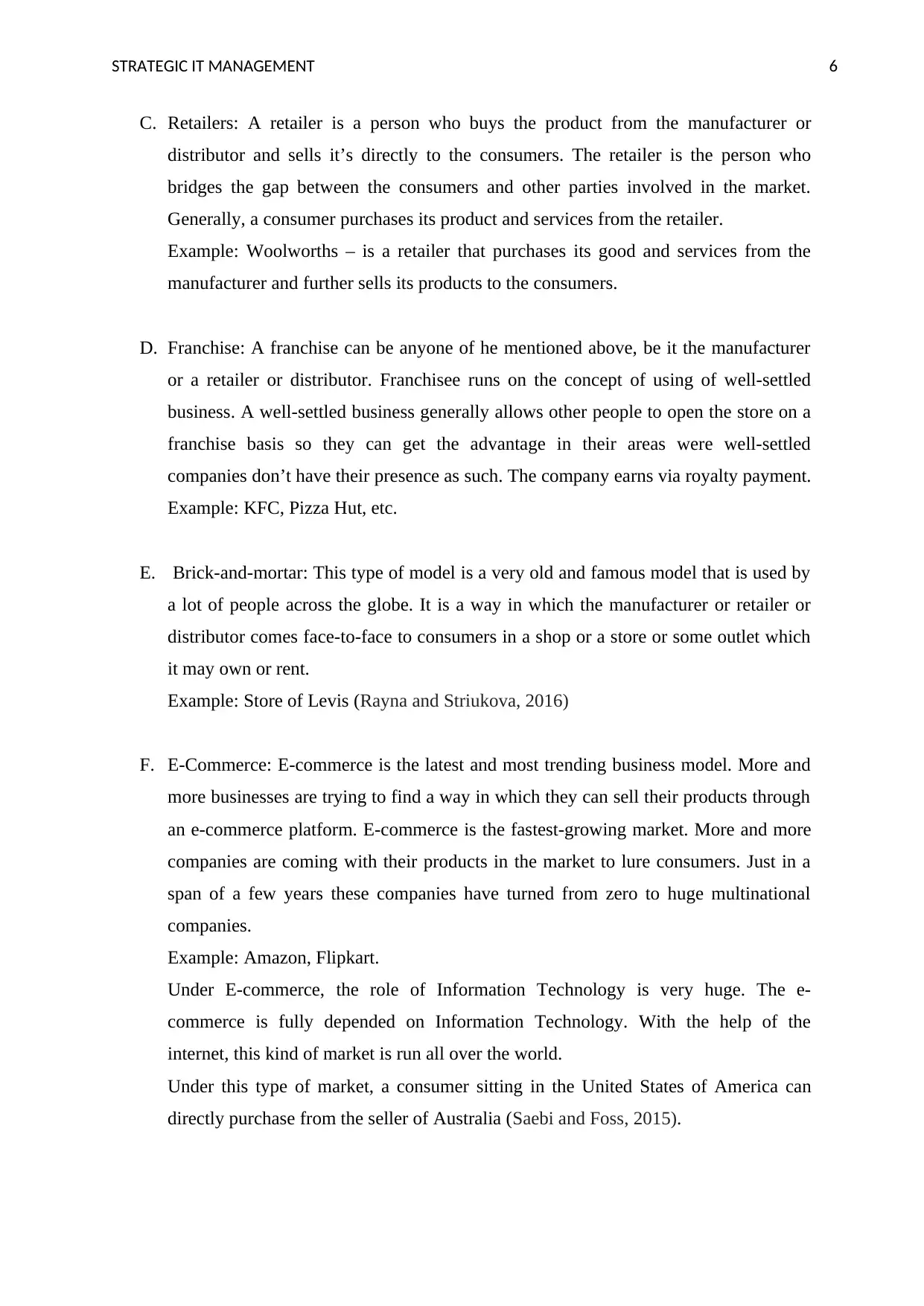
STRATEGIC IT MANAGEMENT 6
C. Retailers: A retailer is a person who buys the product from the manufacturer or
distributor and sells it’s directly to the consumers. The retailer is the person who
bridges the gap between the consumers and other parties involved in the market.
Generally, a consumer purchases its product and services from the retailer.
Example: Woolworths – is a retailer that purchases its good and services from the
manufacturer and further sells its products to the consumers.
D. Franchise: A franchise can be anyone of he mentioned above, be it the manufacturer
or a retailer or distributor. Franchisee runs on the concept of using of well-settled
business. A well-settled business generally allows other people to open the store on a
franchise basis so they can get the advantage in their areas were well-settled
companies don’t have their presence as such. The company earns via royalty payment.
Example: KFC, Pizza Hut, etc.
E. Brick-and-mortar: This type of model is a very old and famous model that is used by
a lot of people across the globe. It is a way in which the manufacturer or retailer or
distributor comes face-to-face to consumers in a shop or a store or some outlet which
it may own or rent.
Example: Store of Levis (Rayna and Striukova, 2016)
F. E-Commerce: E-commerce is the latest and most trending business model. More and
more businesses are trying to find a way in which they can sell their products through
an e-commerce platform. E-commerce is the fastest-growing market. More and more
companies are coming with their products in the market to lure consumers. Just in a
span of a few years these companies have turned from zero to huge multinational
companies.
Example: Amazon, Flipkart.
Under E-commerce, the role of Information Technology is very huge. The e-
commerce is fully depended on Information Technology. With the help of the
internet, this kind of market is run all over the world.
Under this type of market, a consumer sitting in the United States of America can
directly purchase from the seller of Australia (Saebi and Foss, 2015).
C. Retailers: A retailer is a person who buys the product from the manufacturer or
distributor and sells it’s directly to the consumers. The retailer is the person who
bridges the gap between the consumers and other parties involved in the market.
Generally, a consumer purchases its product and services from the retailer.
Example: Woolworths – is a retailer that purchases its good and services from the
manufacturer and further sells its products to the consumers.
D. Franchise: A franchise can be anyone of he mentioned above, be it the manufacturer
or a retailer or distributor. Franchisee runs on the concept of using of well-settled
business. A well-settled business generally allows other people to open the store on a
franchise basis so they can get the advantage in their areas were well-settled
companies don’t have their presence as such. The company earns via royalty payment.
Example: KFC, Pizza Hut, etc.
E. Brick-and-mortar: This type of model is a very old and famous model that is used by
a lot of people across the globe. It is a way in which the manufacturer or retailer or
distributor comes face-to-face to consumers in a shop or a store or some outlet which
it may own or rent.
Example: Store of Levis (Rayna and Striukova, 2016)
F. E-Commerce: E-commerce is the latest and most trending business model. More and
more businesses are trying to find a way in which they can sell their products through
an e-commerce platform. E-commerce is the fastest-growing market. More and more
companies are coming with their products in the market to lure consumers. Just in a
span of a few years these companies have turned from zero to huge multinational
companies.
Example: Amazon, Flipkart.
Under E-commerce, the role of Information Technology is very huge. The e-
commerce is fully depended on Information Technology. With the help of the
internet, this kind of market is run all over the world.
Under this type of market, a consumer sitting in the United States of America can
directly purchase from the seller of Australia (Saebi and Foss, 2015).
Paraphrase This Document
Need a fresh take? Get an instant paraphrase of this document with our AI Paraphraser
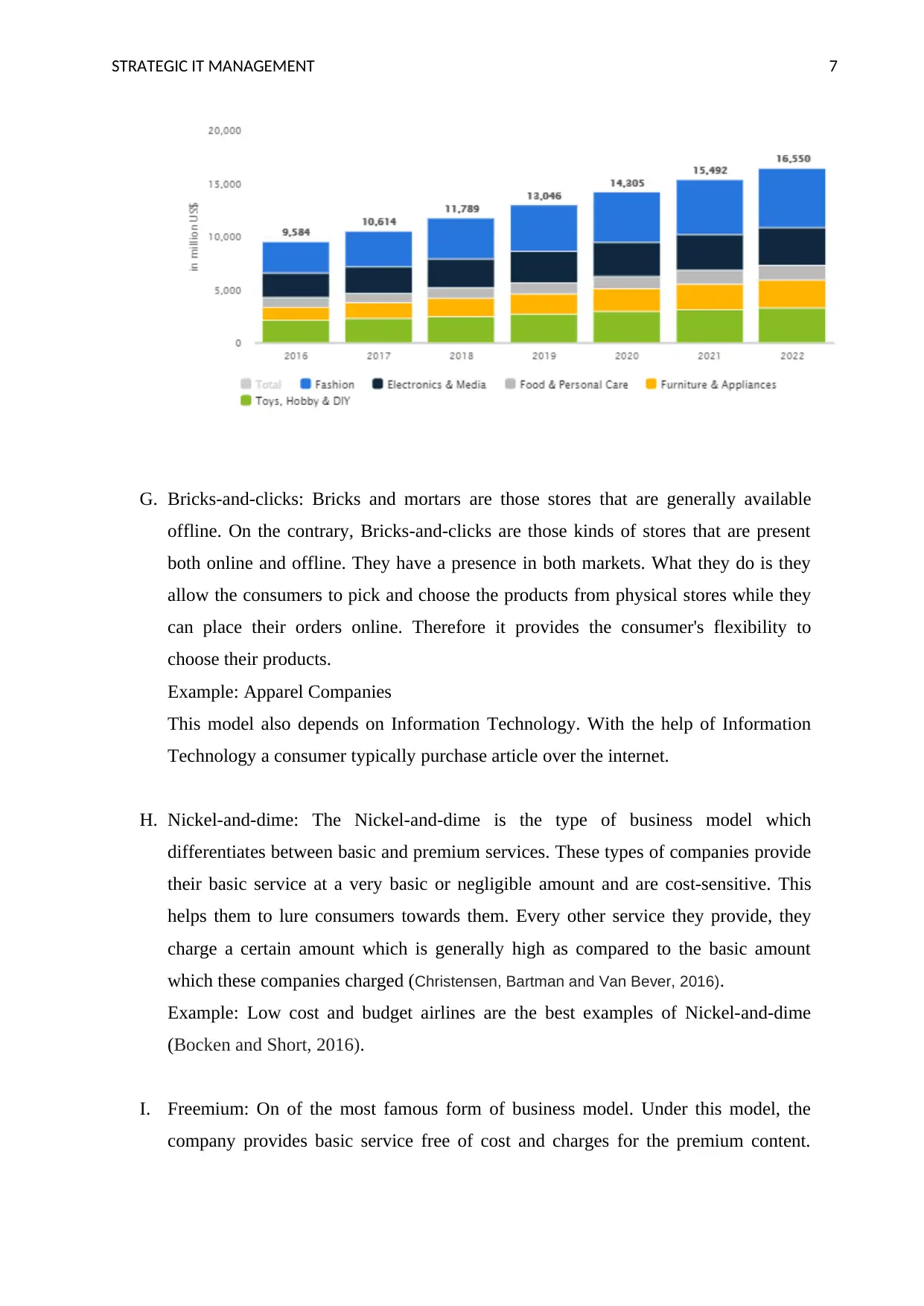
STRATEGIC IT MANAGEMENT 7
G. Bricks-and-clicks: Bricks and mortars are those stores that are generally available
offline. On the contrary, Bricks-and-clicks are those kinds of stores that are present
both online and offline. They have a presence in both markets. What they do is they
allow the consumers to pick and choose the products from physical stores while they
can place their orders online. Therefore it provides the consumer's flexibility to
choose their products.
Example: Apparel Companies
This model also depends on Information Technology. With the help of Information
Technology a consumer typically purchase article over the internet.
H. Nickel-and-dime: The Nickel-and-dime is the type of business model which
differentiates between basic and premium services. These types of companies provide
their basic service at a very basic or negligible amount and are cost-sensitive. This
helps them to lure consumers towards them. Every other service they provide, they
charge a certain amount which is generally high as compared to the basic amount
which these companies charged (Christensen, Bartman and Van Bever, 2016).
Example: Low cost and budget airlines are the best examples of Nickel-and-dime
(Bocken and Short, 2016).
I. Freemium: On of the most famous form of business model. Under this model, the
company provides basic service free of cost and charges for the premium content.
G. Bricks-and-clicks: Bricks and mortars are those stores that are generally available
offline. On the contrary, Bricks-and-clicks are those kinds of stores that are present
both online and offline. They have a presence in both markets. What they do is they
allow the consumers to pick and choose the products from physical stores while they
can place their orders online. Therefore it provides the consumer's flexibility to
choose their products.
Example: Apparel Companies
This model also depends on Information Technology. With the help of Information
Technology a consumer typically purchase article over the internet.
H. Nickel-and-dime: The Nickel-and-dime is the type of business model which
differentiates between basic and premium services. These types of companies provide
their basic service at a very basic or negligible amount and are cost-sensitive. This
helps them to lure consumers towards them. Every other service they provide, they
charge a certain amount which is generally high as compared to the basic amount
which these companies charged (Christensen, Bartman and Van Bever, 2016).
Example: Low cost and budget airlines are the best examples of Nickel-and-dime
(Bocken and Short, 2016).
I. Freemium: On of the most famous form of business model. Under this model, the
company provides basic service free of cost and charges for the premium content.
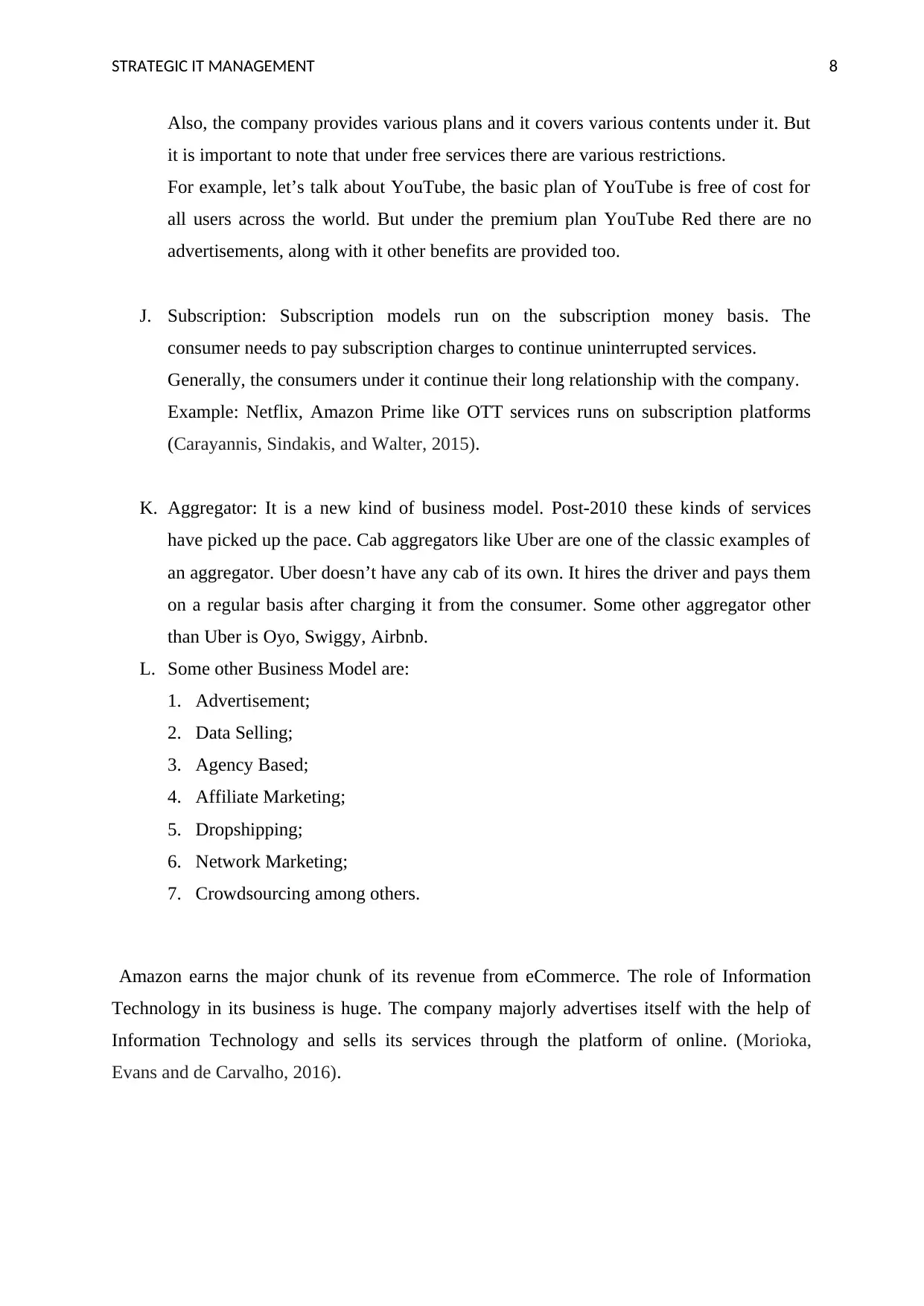
STRATEGIC IT MANAGEMENT 8
Also, the company provides various plans and it covers various contents under it. But
it is important to note that under free services there are various restrictions.
For example, let’s talk about YouTube, the basic plan of YouTube is free of cost for
all users across the world. But under the premium plan YouTube Red there are no
advertisements, along with it other benefits are provided too.
J. Subscription: Subscription models run on the subscription money basis. The
consumer needs to pay subscription charges to continue uninterrupted services.
Generally, the consumers under it continue their long relationship with the company.
Example: Netflix, Amazon Prime like OTT services runs on subscription platforms
(Carayannis, Sindakis, and Walter, 2015).
K. Aggregator: It is a new kind of business model. Post-2010 these kinds of services
have picked up the pace. Cab aggregators like Uber are one of the classic examples of
an aggregator. Uber doesn’t have any cab of its own. It hires the driver and pays them
on a regular basis after charging it from the consumer. Some other aggregator other
than Uber is Oyo, Swiggy, Airbnb.
L. Some other Business Model are:
1. Advertisement;
2. Data Selling;
3. Agency Based;
4. Affiliate Marketing;
5. Dropshipping;
6. Network Marketing;
7. Crowdsourcing among others.
Amazon earns the major chunk of its revenue from eCommerce. The role of Information
Technology in its business is huge. The company majorly advertises itself with the help of
Information Technology and sells its services through the platform of online. (Morioka,
Evans and de Carvalho, 2016).
Also, the company provides various plans and it covers various contents under it. But
it is important to note that under free services there are various restrictions.
For example, let’s talk about YouTube, the basic plan of YouTube is free of cost for
all users across the world. But under the premium plan YouTube Red there are no
advertisements, along with it other benefits are provided too.
J. Subscription: Subscription models run on the subscription money basis. The
consumer needs to pay subscription charges to continue uninterrupted services.
Generally, the consumers under it continue their long relationship with the company.
Example: Netflix, Amazon Prime like OTT services runs on subscription platforms
(Carayannis, Sindakis, and Walter, 2015).
K. Aggregator: It is a new kind of business model. Post-2010 these kinds of services
have picked up the pace. Cab aggregators like Uber are one of the classic examples of
an aggregator. Uber doesn’t have any cab of its own. It hires the driver and pays them
on a regular basis after charging it from the consumer. Some other aggregator other
than Uber is Oyo, Swiggy, Airbnb.
L. Some other Business Model are:
1. Advertisement;
2. Data Selling;
3. Agency Based;
4. Affiliate Marketing;
5. Dropshipping;
6. Network Marketing;
7. Crowdsourcing among others.
Amazon earns the major chunk of its revenue from eCommerce. The role of Information
Technology in its business is huge. The company majorly advertises itself with the help of
Information Technology and sells its services through the platform of online. (Morioka,
Evans and de Carvalho, 2016).
⊘ This is a preview!⊘
Do you want full access?
Subscribe today to unlock all pages.

Trusted by 1+ million students worldwide
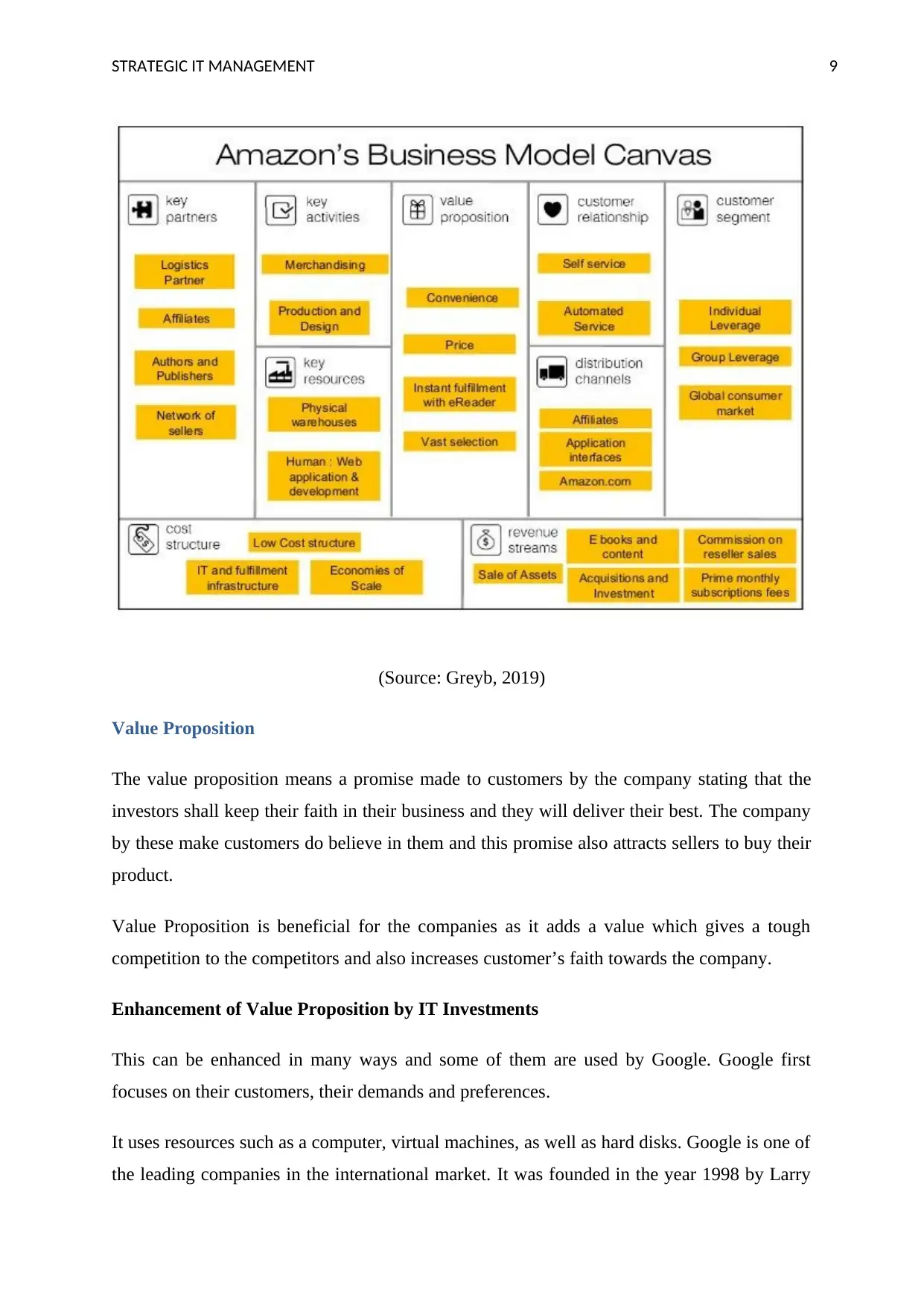
STRATEGIC IT MANAGEMENT 9
(Source: Greyb, 2019)
Value Proposition
The value proposition means a promise made to customers by the company stating that the
investors shall keep their faith in their business and they will deliver their best. The company
by these make customers do believe in them and this promise also attracts sellers to buy their
product.
Value Proposition is beneficial for the companies as it adds a value which gives a tough
competition to the competitors and also increases customer’s faith towards the company.
Enhancement of Value Proposition by IT Investments
This can be enhanced in many ways and some of them are used by Google. Google first
focuses on their customers, their demands and preferences.
It uses resources such as a computer, virtual machines, as well as hard disks. Google is one of
the leading companies in the international market. It was founded in the year 1998 by Larry
(Source: Greyb, 2019)
Value Proposition
The value proposition means a promise made to customers by the company stating that the
investors shall keep their faith in their business and they will deliver their best. The company
by these make customers do believe in them and this promise also attracts sellers to buy their
product.
Value Proposition is beneficial for the companies as it adds a value which gives a tough
competition to the competitors and also increases customer’s faith towards the company.
Enhancement of Value Proposition by IT Investments
This can be enhanced in many ways and some of them are used by Google. Google first
focuses on their customers, their demands and preferences.
It uses resources such as a computer, virtual machines, as well as hard disks. Google is one of
the leading companies in the international market. It was founded in the year 1998 by Larry
Paraphrase This Document
Need a fresh take? Get an instant paraphrase of this document with our AI Paraphraser

STRATEGIC IT MANAGEMENT 10
Page and Sergey Brin. It is a search Engine Company that provides a variety of services to its
consumers. The company has adopted an effective business model that made them
competitive in the market.
Through IT Investments a company’s value increases, some of the ways are as follows:
Capacity to produce – Company with the help of technology can update their capacity to
deliver service which increases more demand and more profit. Employees enjoy working in a
new tech environment as new and updated technologies will be provided to them which will
attract them and their efforts will be more to do desired work (Payne, Frow and Eggert,
2017).
Capital Requirements – More investments lead to more capital which will fulfill the
requirements of the company, as in Google there are a lot of investors which has invested in
the company which leads to the growth of the company, also the value of Google in the
market is getting high day by day. Compare to other companies Google has better goodwill
which is important to run the business as it aids the company to maintain better relations with
the consumers and investors.
Cost Reduced - IT Investment will provide methods to make the best possible cost minimum
technique and profit maximization techniques. Larger the investments, the companies
expenses will reduce day by day with the help of cost minimization techniques. Google has
now started dealing with the companies to buy products at the lowest price and they sell them
at cheaper rates than the market.
This all enhances a company’s growth and productivity and its effect are also seen in the
performance of the company. The growth of a particular company also helps the economy to
grow. Google makes believe to customers that their service is of good quality and are
available at lower rates than the market. This induces customers to buy from Google instead
of another competitor (Whittaker, Montgomery and Acosta, 2015)
IT investment initiates companies to make a step forward. IT brings down the cost of
investment which turns into more and more profit. One such example is: Some kinds of
companies maintain employees to maintain the record and to arrange that record, but with the
help of Google cloud this work can be done easily and rapidly which saves the cost of the
company. It also helps the company to be more and more competitive in the market which
Page and Sergey Brin. It is a search Engine Company that provides a variety of services to its
consumers. The company has adopted an effective business model that made them
competitive in the market.
Through IT Investments a company’s value increases, some of the ways are as follows:
Capacity to produce – Company with the help of technology can update their capacity to
deliver service which increases more demand and more profit. Employees enjoy working in a
new tech environment as new and updated technologies will be provided to them which will
attract them and their efforts will be more to do desired work (Payne, Frow and Eggert,
2017).
Capital Requirements – More investments lead to more capital which will fulfill the
requirements of the company, as in Google there are a lot of investors which has invested in
the company which leads to the growth of the company, also the value of Google in the
market is getting high day by day. Compare to other companies Google has better goodwill
which is important to run the business as it aids the company to maintain better relations with
the consumers and investors.
Cost Reduced - IT Investment will provide methods to make the best possible cost minimum
technique and profit maximization techniques. Larger the investments, the companies
expenses will reduce day by day with the help of cost minimization techniques. Google has
now started dealing with the companies to buy products at the lowest price and they sell them
at cheaper rates than the market.
This all enhances a company’s growth and productivity and its effect are also seen in the
performance of the company. The growth of a particular company also helps the economy to
grow. Google makes believe to customers that their service is of good quality and are
available at lower rates than the market. This induces customers to buy from Google instead
of another competitor (Whittaker, Montgomery and Acosta, 2015)
IT investment initiates companies to make a step forward. IT brings down the cost of
investment which turns into more and more profit. One such example is: Some kinds of
companies maintain employees to maintain the record and to arrange that record, but with the
help of Google cloud this work can be done easily and rapidly which saves the cost of the
company. It also helps the company to be more and more competitive in the market which
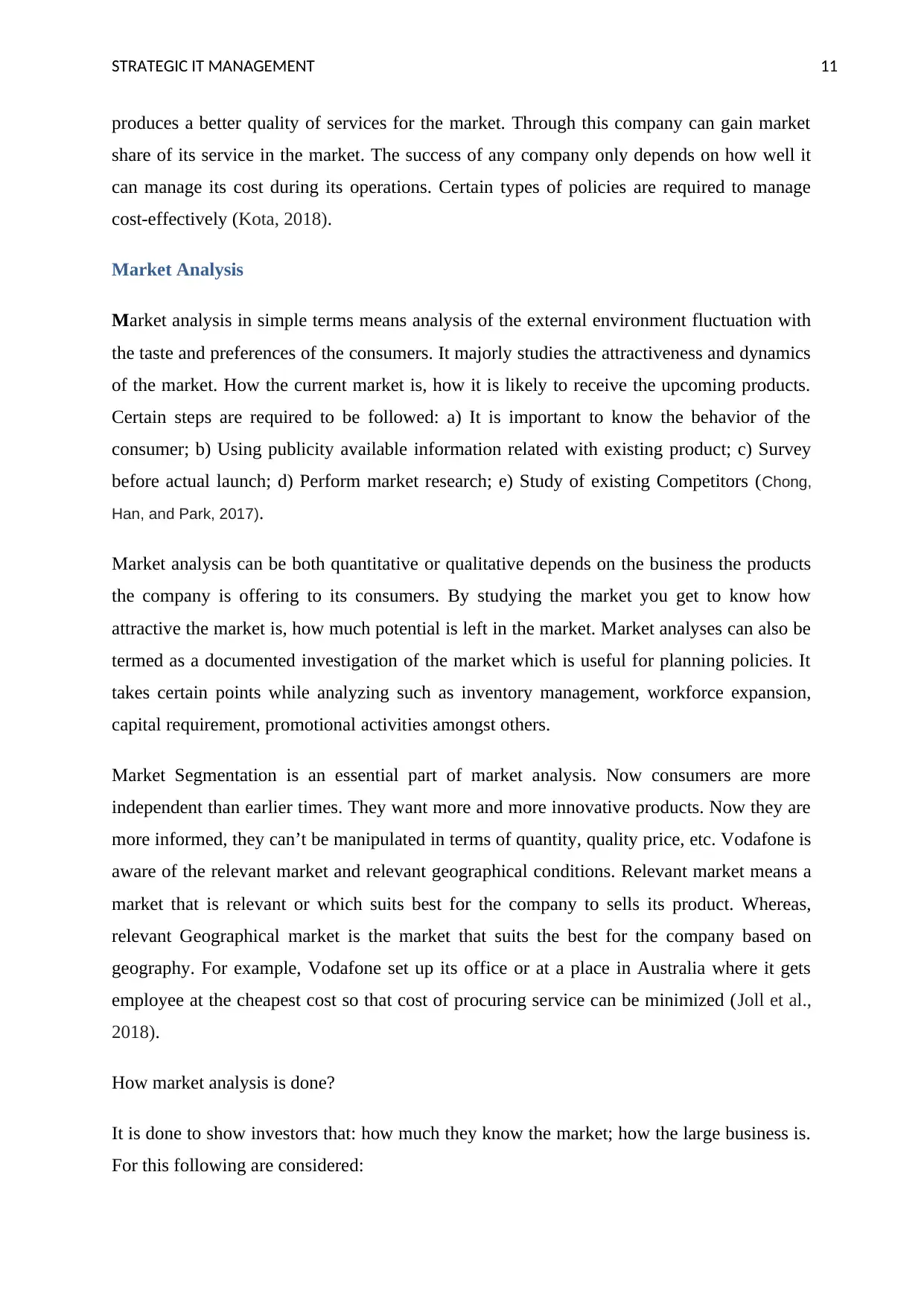
STRATEGIC IT MANAGEMENT 11
produces a better quality of services for the market. Through this company can gain market
share of its service in the market. The success of any company only depends on how well it
can manage its cost during its operations. Certain types of policies are required to manage
cost-effectively (Kota, 2018).
Market Analysis
Market analysis in simple terms means analysis of the external environment fluctuation with
the taste and preferences of the consumers. It majorly studies the attractiveness and dynamics
of the market. How the current market is, how it is likely to receive the upcoming products.
Certain steps are required to be followed: a) It is important to know the behavior of the
consumer; b) Using publicity available information related with existing product; c) Survey
before actual launch; d) Perform market research; e) Study of existing Competitors (Chong,
Han, and Park, 2017).
Market analysis can be both quantitative or qualitative depends on the business the products
the company is offering to its consumers. By studying the market you get to know how
attractive the market is, how much potential is left in the market. Market analyses can also be
termed as a documented investigation of the market which is useful for planning policies. It
takes certain points while analyzing such as inventory management, workforce expansion,
capital requirement, promotional activities amongst others.
Market Segmentation is an essential part of market analysis. Now consumers are more
independent than earlier times. They want more and more innovative products. Now they are
more informed, they can’t be manipulated in terms of quantity, quality price, etc. Vodafone is
aware of the relevant market and relevant geographical conditions. Relevant market means a
market that is relevant or which suits best for the company to sells its product. Whereas,
relevant Geographical market is the market that suits the best for the company based on
geography. For example, Vodafone set up its office or at a place in Australia where it gets
employee at the cheapest cost so that cost of procuring service can be minimized (Joll et al.,
2018).
How market analysis is done?
It is done to show investors that: how much they know the market; how the large business is.
For this following are considered:
produces a better quality of services for the market. Through this company can gain market
share of its service in the market. The success of any company only depends on how well it
can manage its cost during its operations. Certain types of policies are required to manage
cost-effectively (Kota, 2018).
Market Analysis
Market analysis in simple terms means analysis of the external environment fluctuation with
the taste and preferences of the consumers. It majorly studies the attractiveness and dynamics
of the market. How the current market is, how it is likely to receive the upcoming products.
Certain steps are required to be followed: a) It is important to know the behavior of the
consumer; b) Using publicity available information related with existing product; c) Survey
before actual launch; d) Perform market research; e) Study of existing Competitors (Chong,
Han, and Park, 2017).
Market analysis can be both quantitative or qualitative depends on the business the products
the company is offering to its consumers. By studying the market you get to know how
attractive the market is, how much potential is left in the market. Market analyses can also be
termed as a documented investigation of the market which is useful for planning policies. It
takes certain points while analyzing such as inventory management, workforce expansion,
capital requirement, promotional activities amongst others.
Market Segmentation is an essential part of market analysis. Now consumers are more
independent than earlier times. They want more and more innovative products. Now they are
more informed, they can’t be manipulated in terms of quantity, quality price, etc. Vodafone is
aware of the relevant market and relevant geographical conditions. Relevant market means a
market that is relevant or which suits best for the company to sells its product. Whereas,
relevant Geographical market is the market that suits the best for the company based on
geography. For example, Vodafone set up its office or at a place in Australia where it gets
employee at the cheapest cost so that cost of procuring service can be minimized (Joll et al.,
2018).
How market analysis is done?
It is done to show investors that: how much they know the market; how the large business is.
For this following are considered:
⊘ This is a preview!⊘
Do you want full access?
Subscribe today to unlock all pages.

Trusted by 1+ million students worldwide
1 out of 26
Related Documents
Your All-in-One AI-Powered Toolkit for Academic Success.
+13062052269
info@desklib.com
Available 24*7 on WhatsApp / Email
![[object Object]](/_next/static/media/star-bottom.7253800d.svg)
Unlock your academic potential
Copyright © 2020–2025 A2Z Services. All Rights Reserved. Developed and managed by ZUCOL.




